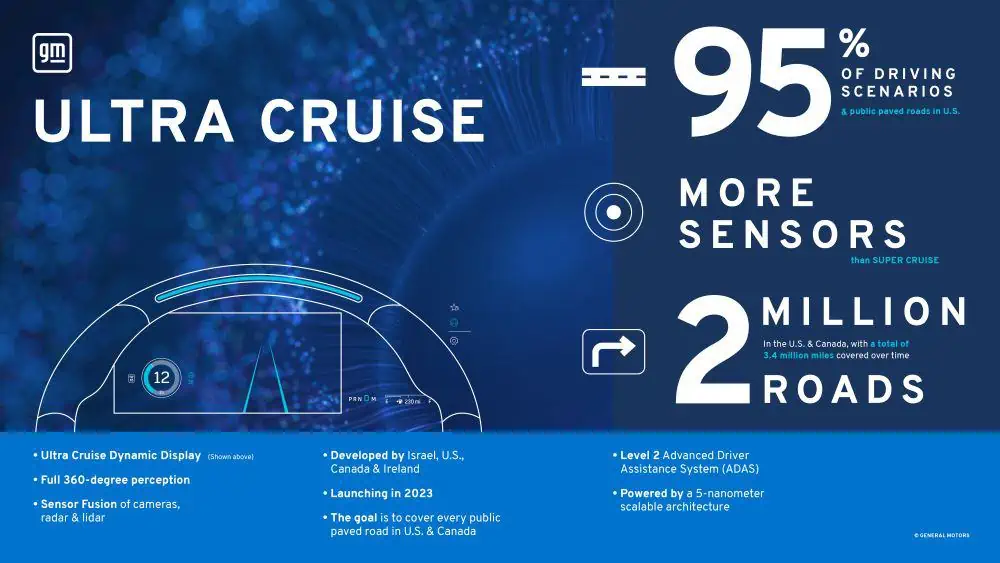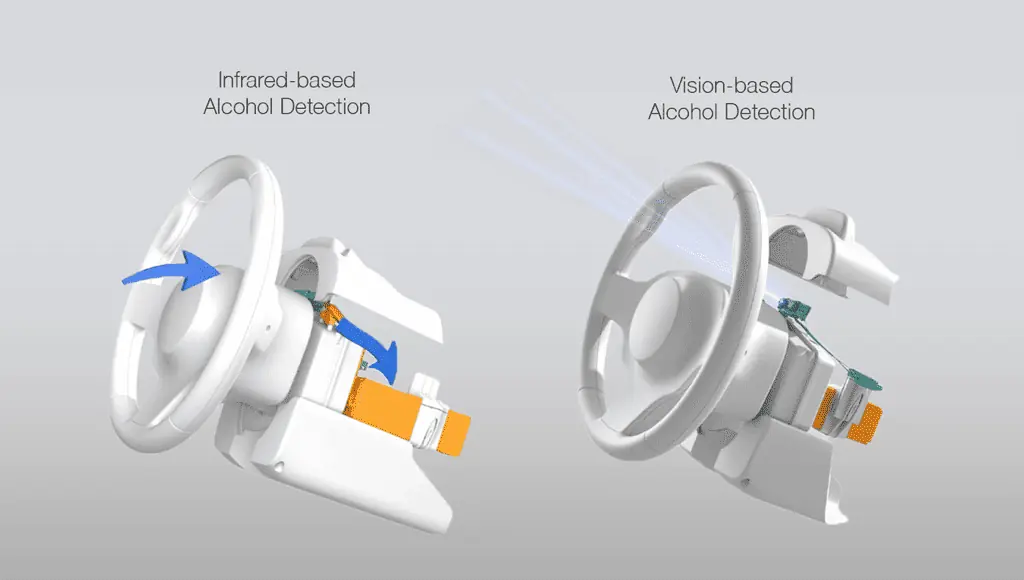
(Image: GM)
By Colin Barnden
What’s at stake:
General Motors is ending the Ultra Cruise program. Is this the beginning of a wider shift in the auto industry away from hands-off and eyes-off driving, or just the next step for GM to move away from driving automation following the troubles at its autonomous subsidiary Cruise?
GM launched its original hands-off Super Cruise system in 2017 in the Cadillac CT6. The system received rave reports in the press and also in reviews from Consumer Reports, which has repeatedly stressed the importance of hands-off driving being limited to divided highways only. So successful was Super Cruise that Ford launched a similar system, called BlueCruise, in 2021.
No sooner had it launched than GM lost its way with Super Cruise. Rather than expanding roll-out of the system to practically every suitable model sold in the U.S. and Canada, GM instead prioritized resources onto full automation within its Cruise robotaxi subsidiary, and onto a successor to Super Cruise, known as Ultra Cruise.
| Year | Company | ADAS brand | What it actually does |
| 2017 | GM | Super Cruise | Hands-free driving limited to divided highway |
| 2021 | Ford | BlueCruise | Hands-free driving limited to divided highway |
| 2021 – 2023 launch delayed – 2024 cancelled | GM | Ultra Cruise | Designed as upgrade to Super Cruise. GM claimed that it will offer hands-free driving covering 95 percent of driving scenarios on 2 million roads in the US and Canada |
| 2022 – suspended in 2023 | GM subsidiary Cruise | Level 4 robotaxis | Cruise suspended all U.S. robotaxi operations in Oct. 2023 |
But GM ran before it could walk. So desperate was the company to prove that it could out-Tesla Tesla, it developed Ultra Cruise to work not just on 130,000 miles of lidar-mapped highways, but with a goal to work on every public paved road in the U.S. and Canada.
Hands-off driving limited to divided highways only is one thing, but hands-off driving on every public paved road in the U.S. and Canada is an entirely different public safety proposition.

Frankly, Ultra Cruise was a terrible proposition. In October 2021 when GM announced the system I wrote:
Ultra Cruise enables rich, lazy people to ride in 6,000-lb tanks in close proximity to vulnerable road users without the onerous task of steering. What a stupid idea.
With a planned introduction for 2023, problems with Ultra Cruise were evident in July last year, when reports surfaced that the launch of the system was to be delayed until 2024, “when the company [GM] is certain it’s ready to safely deploy the technology.”
Fast-forward to this week, with the nation’s tech press mostly in post-CES recovery mode and right on the Martin Luther King Jr. federal holiday, it was announced that GM is shutting down the Ultra Cruise program. CNBC reports:
Two sources familiar with the system told CNBC that the automaker is ending the Ultra Cruise program. One source said GM has decided to instead focus on the current Super Cruise system and expanding its capabilities.
The problem? Hands-off driving in close proximity to vulnerable road users isn’t safe.
Safety vs. convenience
Hands-off driving is a convenience feature not a safety feature. The very act of the driver taking their hands off the steering wheel automatically leads to disengagement from the driving task. No matter how subtly it occurs, hands-off driving leads to mind-off driving, which compromises safety.
Imagine a driver holding a coffee cup and a burger at the precise instant a safety-critical situation occurs, and the problem with hands-off driving becomes apparent: The driver isn’t necessarily available to instantaneously retake control.
The safest driver is an alert, engaged, and unimpaired human driver with hands on the wheel, eyes on the road, and mind on the task of driving. But driving suddenly seems to be a boring and burdensome task for many folk, who now would rather a machine did it all for them while they instead concentrate on their smartphone.
As GM has realized, seeking to remove humans from the driving task, while leaving them legally liable for the driving task, both hinders efforts to make public roads safer, and throws their customers under the proverbial bus. What worked for Tesla won’t work for GM.
Public roads are shared spaces, but many automakers in the U.S. seem incapable of understanding what those words truly mean. If the auto industry absolutely must go down the route of hands-off driving, it is going to have to go back to limiting operation to divided highways only, and away from pedestrians and bicyclists.
Thus, GM is to focus once again on Super Cruise. But where does that leave Ford’s plans for an eyes-off system? Or Mobileye, which also has a roadmap for eyes-off driving? How about the comical “Level 3” systems from OEMs like Mercedes-Benz, that generate lots of press excitement, but cannot address the fundamental issue of liability?
Is GM an outlier, or simply the first of many?
Making human drivers safer
After a decade of “keeping up with Elon,” automakers are beginning to understand that, just like EV adoption, increased levels of driving automation aren’t necessarily what customers want. The “innovators” and “early adopters” may love janky “self-driving” software, but the majority of consumers do not, and certainly don’t want to pay a monthly subscription for features that make driving harder and where they are liable for consequences of decisions made by a software driver.
Where is the auto industry headed now? Towards advanced safety features which make human drivers safer. In December NHTSA (National Highway Traffic Safety Administration) issued an Advance Notice of Proposed Rulemaking for impaired driving, to mitigate distracted, drowsy, and drunk driving.
Mitigating distracted, drowsy, and drunk driving is the primary role of a driver monitoring system (DMS). At CES, Magna demonstrated a multi-modal impaired driving prevention system with 99% reliability that combines a vision-based DMS with an alcohol and carbon dioxide sensor.

This system has the potential to save tens of thousands of lives each year on U.S. roads, but of course it was generative AI that instead generated most of the CES headlines.
Where next for GM? It took a beating over the Cruise saga, but it looks to be on the right track already with a renewed focus on Super Cruise.
GM also generated a lot of headlines with its decision last year to drop Apple CarPlay and Android Auto. In the short-term it could do a lot worse than follow BMW’s lead and talk to Valeo about developing an advanced digital cockpit that safely puts the driver at the center of the immersive user experience.
In 2024, many more automakers may find themselves asking “Who needs Apple?”
It is early days, but perhaps the new winning strategy for the U.S. auto industry is giving customers a safe product that they actually want to own and drive. That idea is so innovative and “out there” that maybe it is radical enough to appear on the CES show floor in a year or two.
Bottom line:
A significant win for road safety would be for NHTSA to dictate that the operational design domain for hands-off and eyes-off driving systems be limited to divided-highways only. That decision would save the automakers from themselves, from each other, and from a pointless race to “full self-driving” which is anything but self-driving, and certainly isn’t safe.
Colin Barnden is principal analyst at Semicast Research. He can be reached at colin.barnden@semicast.net.
Copyright permission/reprint service of a full Ojo-Yoshida Report story is available for promotional use on your website, marketing materials and social media promotions. Please send us an email at talktous@ojoyoshidareport.com for details.
